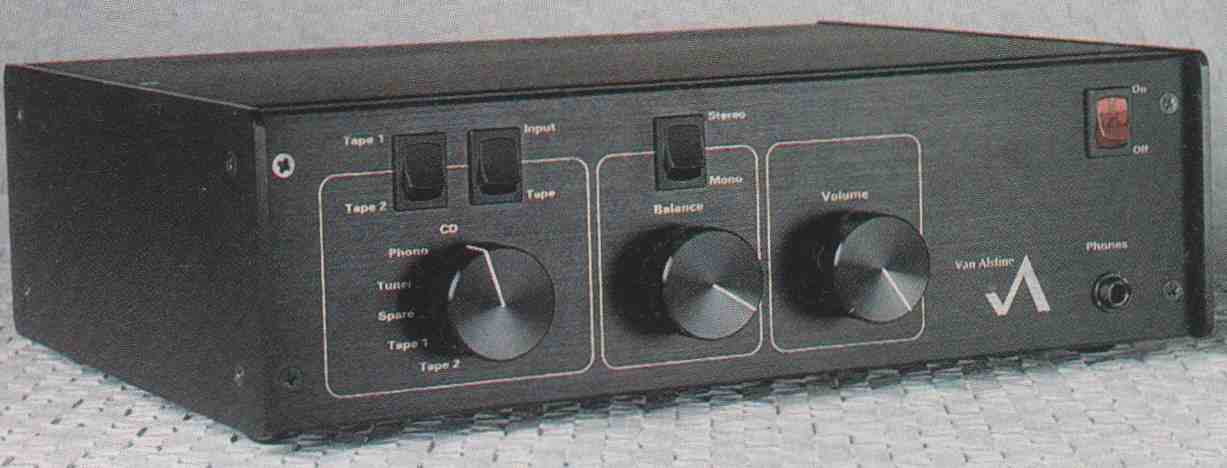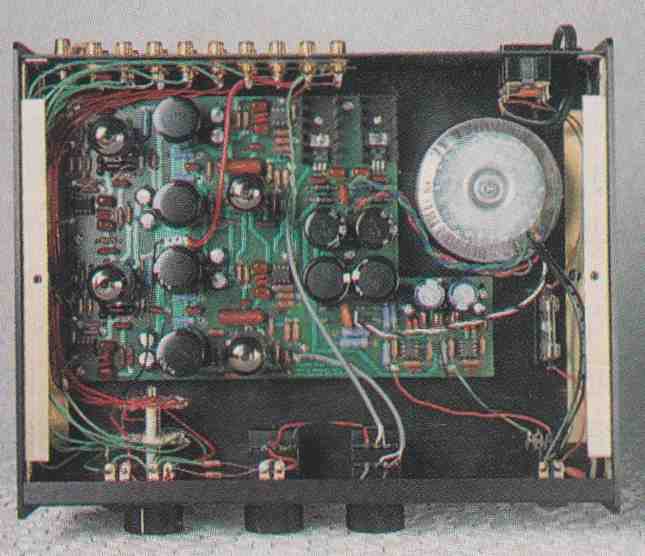Van Alstine’s Super Pas 4 pre-amplifier is not unusual in being a hybrid design (four 12AX7A vacuum tubes sup ported by a panoply of solid-state devices) and certainly not in taking a minimalist approach (volume and balance controls, selector switch, two tape loops, and a headphone jack are all you get). It is special in being a kit, at a time when even the redoubtable Heath Company has fled the field, declaring that its former customers are now too busy programming their computers to bother with soldering irons. Building this kit ($595, ca. 1993) affords a $200 saving over the wired version, and it also enables you to more easily admire the quality of the parts included (e.g., all American- made Dale 1% resistors, in my sample, and top-quality controls, most of them environmentally sealed).


Frank Van Alstine, known for modifying products manufactured by the original Dynaco (which closed its doors in the late 1970s), has also long been a manufacturer of original designs. Though its model name is similar to that of a familiar Dynaco product, the Super Pas 4i falls into the latter category. All parts, including the chassis, are new. Each channel uses a 12AX7A for phono and line voltage gain, but the outputs are FET op-amps. The operating instructions claim the sonic virtues of both tubes and transistors but without making clear where their presumed synergy is supposed to lie. The Audio by Van Alstine catalog, however, says that the tubes perform the voltage gain, the solid- state stages serve as current amplifiers and high-speed buffers, and the combination reduces distortion, improves high- and low-frequency linearity, and keeps noise low. The result, a company newsletter claims, is that “there is no solid state sound no mush and rolled off vacuum tube sound -- only delightful transparency.”
The kit I built was a Pas 4, a model that was supplanted, midway in my review process, by the Pas 4i. So while I can comment on the sound of both versions, my comments on assembly apply more strictly to the older one. In build complexity, that kit fell somewhere between a fully prepackaged Heathkit or Dynakit and an Audio Amateur project. All necessary parts were supplied, as was all necessary assembly information, though the instruction manual I worked from did not attempt to be a rigorous, step-by-step guide. Also, I found it helpful to depart from its suggested sequence of operations several times to avoid some tight corners that appeared to be developing. I stated these concerns to Frank Van Alstine, who says he has since incorporated some of my suggestions into the manual for the Pas 4i, now in production. So the 4i manual (which I haven’t seen) should be an improvement in this regard. In any case, Van Alstine says, he revises his manuals frequently, based on errors he finds in home-built units sent to him for checkup. (The price of his kits includes a free checkup after construction; Van Alstine recommends home-built units be sent to him for checking before they’re first turned on, so he can catch any construction errors before they lead to damage.)
The basic layout of both the Pas 4 and 4i is conventional. The chassis floor is occupied by a large double-sided epoxy circuit card with plated-through holes and by a substantial toroidal power transformer. The builder stuffs the card, mounts controls and connectors to front and rear panels, and wires the subassemblies together point-to-point. An accomplished assembler could probably deal with the job in two evenings. (Still trying to adjust to age- related failure of near vision, I had to proceed much more slowly.) It might even be considered a project for a first-timer, although not one so green as to be unable to distinguish between a resistor and a capacitor at first sight.
The assembled preamp, a snug package about the size of a desk dictionary, offers no amenities beyond the headphone amplifier, which is a meticulous design sharing nothing but the power transformer and rectifiers with the rest of the unit. The three polarized a.c. convenience outlets are unswitched. While these outlets are rated at 15 amperes, the manual states that they’re not intended for use with high-powered amplifiers, though I consider such amps otherwise appropriate for use with the Pas 4i. The unit therefore depends solely on it sonic characteristics to win your approbation.
In the earlier Pas 4, those characteristics were not encouraging, and they failed to persuade me that I was listening to sound that is “high end.” Then Van Alstine changed the design. This change, making the preamp the Super Pas 4i, involves merely parts upgrades: Beefier plate capacitors in the line-level stage and new op-amp ICs all around (AD845s to AD843s). Modifying the older version costs $50 for these parts and, if desired, factory installation. I made the alterations on my review sample without mishap, but I am short on appreciative capacity when forced to bumble around in a deep chassis, half blind, with a lethally hot instrument in my hand. So those who need the conversion might prefer having it done by the manufacturer, although I feel that the fun of building a kit includes the fun of modifying it.
I was pleased and impressed by what I heard from the updated unit. It has taken a long stride into the center of the high-end arena. All the signs familiar to audio enthusiasts are present: The solid identity given to the instruments at the back of the orchestra without diminishing those at the front, the exciting contrasts of instrumental blending and divergence that mark a good performance and good playback equipment, and the valuable clues to the acoustical nature of the performing environment.
In addition, for better or worse, the Super Pas 4i does manage to sound like what many enthusiasts expect from an amplifying device that uses vacuum tubes. The highs gleam and tinkle sweetly instead of splashing aggressively, and you no longer drive casual visitors out of the room with a system religiously operated at flat settings. Beware of the risks in this, however. One of my first tests of the preamp was the beginning movement of Mahler: Symphony No. 8 (Telarc CD-80267), a colossally congested piece of work that, dismayingly, began to sound somewhat congested toward the end. But it turned out to be neither the recording nor the playback. It was me. Liking what I heard, I had played it too loud and too long. The whistling in my ears persisted for more than an hour afterward.
Van Alstine has no use for conventional specifications as descriptors of audio quality, so he publishes none. However, a few perfunctory measurements, made after listening and only on the 4i version, suggest he has little to be ashamed of. The performance profile of the Super Pas 4i is generally what you’d expect from a fine vacuum- tube preamplifier. My main caveats are the ph quite low by today’s standards, and that there is no infrasonic filtering which might block record-warp assaults. With the low output cartridges I used for listening evaluations, there were no discernible difficulties—but caution is advised, particularly with marginally stable tonearm/cartridge combinations.
I’d guess that the Super Pas 4i is not the best preamplifier I’ve ever heard—but then, I no longer have that “best” preamp for comparison. I couldn’t afford it and had to send it back. However, I can afford the Pas 4i, so it will stick around, probably plugged in much of the time.
This article adapted from Audio magazine, August 1993.
Also see:
Greg's Unofficial Dynaco Home Page
============